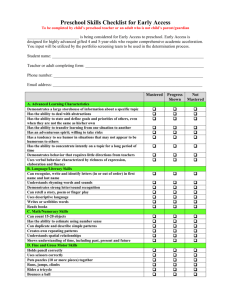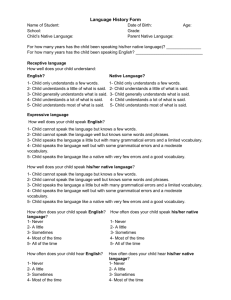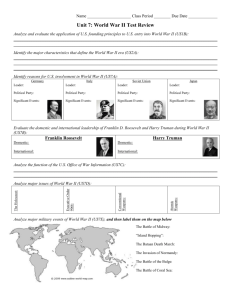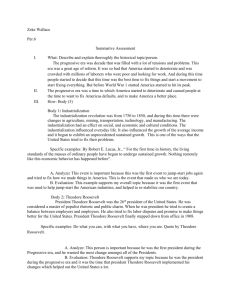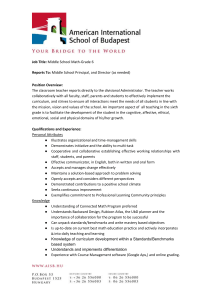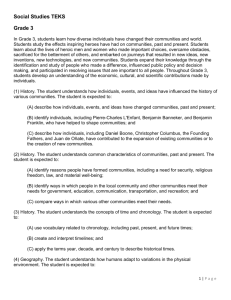Presidential Primary Source Flyer
advertisement
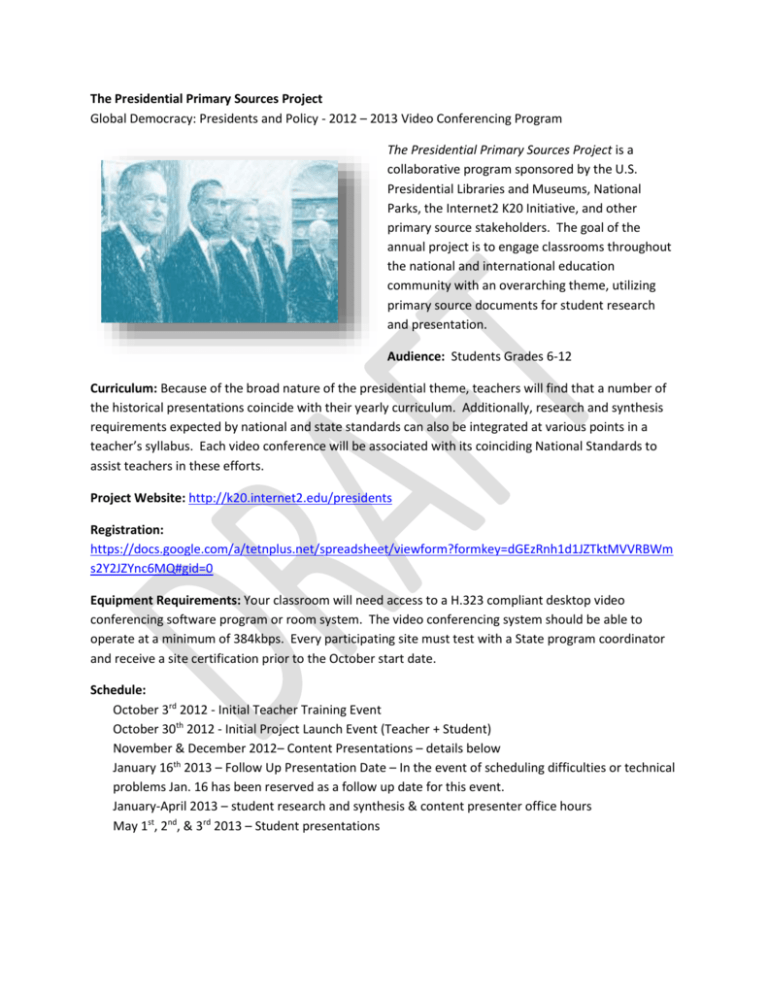
The Presidential Primary Sources Project Global Democracy: Presidents and Policy - 2012 – 2013 Video Conferencing Program The Presidential Primary Sources Project is a collaborative program sponsored by the U.S. Presidential Libraries and Museums, National Parks, the Internet2 K20 Initiative, and other primary source stakeholders. The goal of the annual project is to engage classrooms throughout the national and international education community with an overarching theme, utilizing primary source documents for student research and presentation. Audience: Students Grades 6-12 Curriculum: Because of the broad nature of the presidential theme, teachers will find that a number of the historical presentations coincide with their yearly curriculum. Additionally, research and synthesis requirements expected by national and state standards can also be integrated at various points in a teacher’s syllabus. Each video conference will be associated with its coinciding National Standards to assist teachers in these efforts. Project Website: http://k20.internet2.edu/presidents Registration: https://docs.google.com/a/tetnplus.net/spreadsheet/viewform?formkey=dGEzRnh1d1JZTktMVVRBWm s2Y2JZYnc6MQ#gid=0 Equipment Requirements: Your classroom will need access to a H.323 compliant desktop video conferencing software program or room system. The video conferencing system should be able to operate at a minimum of 384kbps. Every participating site must test with a State program coordinator and receive a site certification prior to the October start date. Schedule: October 3rd 2012 - Initial Teacher Training Event October 30th 2012 - Initial Project Launch Event (Teacher + Student) November & December 2012– Content Presentations – details below January 16th 2013 – Follow Up Presentation Date – In the event of scheduling difficulties or technical problems Jan. 16 has been reserved as a follow up date for this event. January-April 2013 – student research and synthesis & content presenter office hours May 1st, 2nd, & 3rd 2013 – Student presentations Teacher Training Event Library of Congress – Washington, D. C. – 1 Session Oct. 3, 2012 1-2:00 PM PT / 2-3:00 PM MT / 3-4:00 PM CT / 4-5:00 PM ET The teacher primary source document training is a self-guided professional development that culminates in 1 hour Library of Congress facilitated webinar on October 3, 2012. The event will be recorded for teachers unable to attend the final training event. The goal of the workshop is to instruct educators on the inquiry process with primary sources by completing the online workshops from the Library of Congress. Each workshop can be found at the link below. Supporting Inquiry with Primary Sources - 1 hour http://www.loc.gov/teachers/professionaldevelopment/selfdirected/inquiry.html Analyzing Primary Sources: Photographs and Prints - 1 hour http://www.loc.gov/teachers/professionaldevelopment/selfdirected/photographsandprints.html Analyzing Primary Sources: Maps - 1 hour http://www.loc.gov/teachers/professionaldevelopment/selfdirected/maps.html During the culminating portion of the training, teachers will connect with Library of Congress staff for a one-hour webinar on Wednesday, October 3rd from 4-5:00 PM ET. Educators will work though a primary source analysis exercise and view examples of this exercise integrated within online lessons at the Library of Congress (http://www.loc.gov/teachers/classroommaterials/lessons/). Project Launch Oct. 30, 2012 8-8:45 AM PT / 9-9:45 AM MT / 10-10:45 AM CT / 11-11:45 AM ET The Initial Project Launch will introduce teachers and students to the content providers while highlighting the annual schedule and culminating presentations. This exciting fast paced event will help participants get a better grasp of what to expect from the coming months. Key to the success of student presentations will be there utilization of primary source documents. The project launch will help students to better understand the role of primary source documents in research. Content Provider Presentations - All events will be recorded for viewing at your classrooms convenience. George H.W. Bush Presidential Library & Museum (Bush 41) – College Station, TX – 1 Session Nov. 8, 2012 8-8:45 AM PT / 9-9:45 AM MT / 10-10:45 AM CT / 11-11:45 AM ET Expansion of Global Democratization Following the Fall of the Berlin Wall In 1945 at the end of World War II Germany was divided between the victors permitting a nondemocratic Eastern zone led by a German communist party affiliated to the Union of Soviet Socialist Republics (USSR) to exist beside a Western democratic zone of cooperation allied to the United States, Great Britain and France. The city of Berlin located in Eastern Germany was also divided between a free Western democratic zone and a communist zone. To keep the Eastern Germans from fleeing to democratic freedom in the West, in 1961 the East German government built the Berlin Wall. It was a 113-mile concrete and steel wall topped with barbed wire which surrounded the Western sector of occupied Berlin for 28 years. There are two web quests with primary sources (maps, photos, memorandum of telephone conversations and documents) online: www.presidentialtimeline.org/html/educators/GHWB/berlinwall1st_wq/ A geopolitical transformation marking the end of the Cold War and ushering a new era encouraging democratic government happened on Nov. 9, 1989, with the fall of the Berlin Wall. Using key primary sources, an overview will be presented about diplomatic discussions between President Bush and international leaders. This will show how diplomacy helped to change attitudes and generate support of new pro-democracy movements in Eastern Europe. The rise of pro-democracy movements urging self-determination gained momentum with the fall of the Berlin Wall and the collapse of communism in Eastern Europe resulted. US History Content Standards Era 10 – Contemporary United States (1968 to the present) Standard1: Understands developments in foreign policy & domestic politics between the Nixon & Clinton presidencies World History Content Standards Era 9 - The 20th Century Since 1945: Promises and Paradoxes Standard 1 - Understands how post-World War II reconstruction occurred, new international power relations took shape, and colonial empires broke up Standard 2 - Understands the search for community, stability, & peace in an interdependent world Standard 3 - Understands major global trends since World War II National Standards for Civics and Government III.A.1 - students should be able to explain how the United States Constitution grants and distributes power to national and state government and how it seeks to prevent the abuse of power. IV.B.3-Students should be able to evaluate, take, and defend positions on foreign policy issues in light of American national interests, values, and principles. Harry S. Truman Library – Independence, MO – 3 Sessions Nov. 13, 2012 8-8:45 AM PT / 9-9:45 AM MT / 10-10:45 AM CT / 11-11:45 AM ET 10-10:45 AM PT / 11-11:45 AM MT / 12-12:45 PM CT / 1-1:45 PM ET 12-12:45 PM PT / 1-1:45 PM MT / 2-2:45 PM CT / 3-3:45 PM ET Cold War Crisis: Protecting Democracy in Berlin Following World War II, a delicate balance of power had surfaced between Great Britain, the United States, France, and the Soviet Union. The opposing economic structures of capitalism and communism emerged triumphant at the end of the war. The two blossoming superpowers, the United States and the Soviet Union, sought to ensure their permanence by negotiating territorial claims throughout the globe. Germany was divided into fourths. This divided Germany was to become the first battleground of the emerging Cold War between the United States and the Soviet Union. The US and its Allies were determined to protect Democracy in Germany. The Soviets announced a total ground blockade of Berlin in July 1948. What would the Allies do? This presentation utilizes primary sources to examine this Cold War Crisis, the options available to President Truman, and the decisions made in 1948 to protect democracy in Europe. US History Content Standards Era 9-Postwar United States (1945 to early 1970s) Standard 2: How the Cold War and conflicts in Korea and Vietnam influenced domestic and international politics World History Content Standards Era 9-The 20th Century Since 1945: Promises and Paradoxes Standard 1-The student understands major political and economic changes that accompanied post-war recovery. Standard 1-The student understands why global power shifts took place and the Cold War broke out in the aftermath of World War National Standards for Civics and Government IV.B.3-Students should be able to evaluate, take, and defend positions on foreign policy issues in light of American national interests, values, and principles. Theodore Roosevelt Center – Dickinson, ND Nov. 27, 2012 Theodore Roosevelt and the Evolution of American Ideals In a speech explaining the colonial policy of the United States during his presidency, Theodore Roosevelt likened developing nations to children needing governance, stating, “A child has to be governed from without, because it has not yet grown to a point when it can govern itself from within; and a people that shows itself totally unable to govern itself from within must expect to submit to more or less of government from without, because it cannot continue to exist on other terms—indeed, it cannot be permitted permanently to exist as a source of danger to other nations.” This statement reflects a perception of America’s role in the world that was widely held in Roosevelt’s time. Not everyone was as imperialistic as Theodore Roosevelt, but he represented the dominant strain in Republican Party thinking of his time, and to a certain extent the dominant American attitude. In this session, Theodore Roosevelt (portrayed by humanities scholar Clay Jenkinson) will discuss his policies and actions in Cuba, Panama, South America, and the Philippines. Roosevelt’s speeches and writings will provide the foundation for a consideration of how our conception of America’s role in world affairs differed in Roosevelt’s time from our understanding of the ideal of democracy today. As with all humanities programs, the Roosevelt Center believes that a historical figure must be evaluated according to the mores and principles of his time, in context, and with the understanding that views and policies that we now regard as improper or insensitive were, in their time, widely accepted by people of good faith. The Center believes that our role is to evaluate primary source documents with as much contextualization as possible, and with an emphasis on analysis rather than judgment. US History Content Standards Era 7 – The Emergence of Modern America (1890-1930) Standard 2 – Understands the changing role of the United States in world affairs through World War I World History Content Standards Era 8 – A Half-Century of Crisis and Achievement, 1900-1945 Standard 1 – Understands reform, revolution, and social change in the world economy of the early 20th century Standard 2 – Understands the causes and global consequences of World War I National Standards for Civics and Government III.A.1 - students should be able to explain how the United States Constitution grants and distributes power to national and state government and how it seeks to prevent the abuse of power. IV.B.3-Students should be able to evaluate, take, and defend positions on foreign policy issues in light of American national interests, values, and principles. Mount Rushmore National Memorial – Mount Rushmore, SD Dec. 4, 2012 Reflecting the Past, Sculpting the Future: The Evolution of Democracy in America The four presidents on Mount Rushmore National Memorial, George Washington, Thomas Jefferson, Abraham Lincoln, and Theodore Roosevelt, reflect key moments in the evolution of democracy in the United States. Artist Gutzon Borglum described his inspiration behind the “Shrine of Democracy” as “These eleven words ‘man has a right to be free and to be happy’ alone will hold forever the great western experiment as a guiding star.” The actions and decisions of these four presidents represent the evolving country in its early years as we strive to live up to their vision for America. In this distance learning program, we will use primary sources to explore the decisions and beliefs of these four presidents as they set out to ensure that “man has a right to be free and to be happy.” From the debate over the constitution to the concern President Roosevelt had for the working man, the country has been transformed by each democratic decision in history. Focusing on the relevancy of these decisions on our current nation, we will also discuss how this country has evolved since that time and what students can do to participate in the future of the country. US History Content Standards Era 3 – Revolution and the New Nation (1754-1820s) Standard 1 - Understands the causes of the American Revolution, the ideas and interests involved in shaping the revolutionary movement, and reasons for the American victory Standard 2 - Understands the impact of the American Revolution on politics, economy, and society Era 5 – Civil War and Reconstruction (1850-1877) Standard 1 – Understands the causes of the Civil War Standard 2 – Understands the course and character of the Civil War and its effects on the American people Era 7 – The Emergence of Modern America (1890-1930) Standard 2 – Understands the changing role of the United States in world affairs through World World History Content Standards Era 7 – An Age of Revolutions, 1750-1914 Standard 1 – Understands the causes and consequences of political revolutions in the late 18th & early 19th centuries Era 8 – A Half-Century of Crisis and Achievement, 1900-1945 Standard 1 – Understands reform, revolution, and social change in the world economy of the 20th century National Standards for Civics and Government III.A.1 - students should be able to explain how the United States Constitution grants and distributes power to national and state government and how it seeks to prevent the abuse of power. IV.B.3-Students should be able to evaluate, take, and defend positions on foreign policy issues in light of American national interests, values, and principles. Valley Forge National Historical Park - Upper Merion Township, PA – 3 Sessions Dec. 6, 2012 8-8:45 AM PT / 9-9:45 AM MT / 10-10:45 AM CT / 11-11:45 AM ET 10-10:45 AM PT / 11-11:45 AM MT / 12-12:45 PM CT / 1-1:45 PM ET 12-12:45 PM PT / 1-1:45 PM MT / 2-2:45 PM CT / 3-3:45 PM ET Washington’s Leadership in the International Community of the 18th Century Valley Forge National Historical Park will present: “Washington’s Leadership in the Global Community of the 18th Century.” This interactive video conference provides a summary of the significance of Valley Forge National Historical Park, an overview of the 1777-78 winter encampment, and an demonstration of the traits of leadership as demonstrated by General George Washington at the Valley Forge command center of the Continental Army during the Revolutionary War and replicated by the contemporary United States Army in the 21 st century: loyalty, duty, respect, selfless service, honor, integrity and personal courage (LDRSHIP.) Leadership values are illustrated with historic artifacts, paintings and sculpture from Washington’s time and primary sources including Washington’s daily orders, official correspondence, drawings and maps during a distinctive time of international conflict, friendship, rivalry and alliances. Students will have the opportunity to examine the application of the same leadership values in their circles of influence in school, in the family, on the job and in their communities. The program utilizes the power of Prezi, the internet zooming software, and the technology of the Smart Board, so that students in the Valley Forge studio can collect feedback from students in remote classrooms and enter their contributions into the Prezi slides which will then be available on-line for participating classrooms. Extension learning activities will also be available for classroom use or independent study. Cadets from the Valley Forge Military Academy and College will help host the video conference. US History Content Standards Era 3 – Revolution and the New Nation (1754-1820s) Standard 1 - Understands the causes of the American Revolution, the ideas and interests involved in shaping the revolutionary movement, and reasons for the American victory Standard 2 - Understands the impact of the American Revolution on politics, economy, and society Standard 3 - Understands the institutions & practices of government created during the Revolution & how these elements were revised between 1787 & 1815 to create the foundation of the American political system based on the U.S. Constitution and the Bill of Rights World History Content Standards Era 7 – An Age of Revolutions, 1750-1914 Standard 1 – Understands the causes and consequences of political revolutions in the late 18th & early 19th centuries National Standards for Civics and Government III.A.1 - students should be able to explain how the United States Constitution grants and distributes power to national and state government and how it seeks to prevent the abuse of power. Jimmy Carter National Historic Site – Plains, GA Dec. 11, 2012 The Camp David Accords: Exploring a Path to Peace From Plains to the White House, students will explore the childhood of a young, farm boy who would become the 39th President of the United States and the influences that would lead him on a quest for peace. Through this interactive video conference, students will have the opportunity to examine President Carter’s childhood through a multimedia approach. The video conference will also provide students the opportunity to utilize important documents related to the Camp David Accords. Teachers will be provided an array of thought-provoking activities to be used before or after the video conference. This lesson allows teachers to select from activities that incorporate analytical thinking, collaborative discussions, and reflective writing through the use of primary sources. These activities will inspire creativity and problem-resolution. Students’ overall objective is to discover that the path to global peace can begin with them. US History Content Standards Era 10-Contemporary United States (1968 to the present) Standard 1: Understands developments in foreign policy and domestic politics between the Nixon and Clinton presidencies World History Content Standards Era 9-The 20th Century Since 1945: Promises and Paradoxes Standard 2 - Understands the search for community, stability, & peace in an interdependent world Standard 3 - Understands major global trends since World War II National Standards for Civics and Government IV.B.3-Students should be able to evaluate, take, and defend positions on foreign policy issues in light of American national interests, values, and principles.


